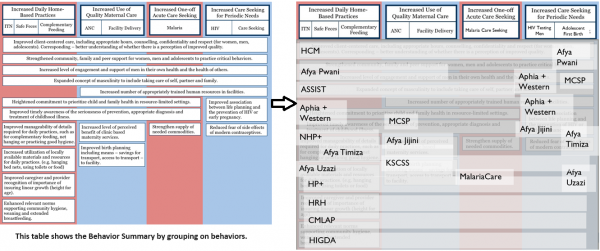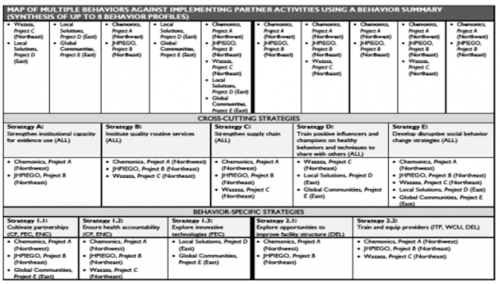It’s time to implement, implement, implement.
The field work has begun and you have a workplan that keeps you and your partners focused on your priority behaviors. But there is one more step you need to take to follow your pathways to change as you implement. You need to map your partners against activities and priority behaviors. That not only keeps everyone on the same page, but also keeps the communities you serve clear on who is doing what for what reasons. It also reduces overlaps, disconnects, and confusions among partners. Whether you have one partner or 10 partners, mapping their activities is a must.
While there are different ways to map partner activities, the BIG process recommends that you map them across (1) locations where they will be carrying out their activities and (2) across behaviors. Again, keep focused on behaviors. (Are you dreaming about behavior-led and behaviorally focused yet? We are!)
With a simple visual presentation of activities, you can see your coverage, your overlaps, and your gaps. All the useful information you need to adjust your implementation plan on an ongoing basis. This visualization can be very simple. In the following example, you take your program's sub-intermediate results…and overlay your partners working on those sub-intermediate results.
Or you could do something more detailed, like the following, where you map by behavior and by strategy or by factor.
Whatever you choose to do, mapping your partners across behaviors will help you: Stay. Focused. On. Behaviors. It’s a mantra. Because it works.
(Need more on mapping? See our handy downloadable guide.)
Lastly, how do you effectively manage these activities as implementation continues?
Ask yourself a series of key questions as you implement. For example:
Progress on Pathways to Change
- As progress on the behavioral outcome indicator is measured, what does the result tell you? How is practice of the behavior changing? Is the pace of change adequate? If not, what actions should be taken?
- Walking through the factors, is positive change occurring? How and how often are measurements taken? What are the measurements telling you? Are they providing the kind of information you need to assess and adapt? Are there any unintended consequences?
- As each supporting actor/influencing audience is engaged: Is each taking the required actions? What is being done to stimulate the required action? What effect is this effort having? What should be done differently?
Primary Actor Steps
- Looking at priority behaviors: Are the primary actors aware of, able to take, and actively taking the steps needed to practice the behavior? If not, what more or different needs to happen?
Partner Collaboration
- In what ways are you collaborating with other implementing partners to achieve the desired behavior change?
- How are established collaboration and coordination mechanisms working?
- To what extent have other implementing partners effectively, and in a timely fashion, carried out activities that you depend on?
- How are your activities and pace impacting other implementing partners?
Next Steps
- What are the next steps that might be required based on your answers to the above: Strategy or workplan revision? The start of the next implementation phase? Meetings, special monitoring, or assessments?
Challenging and reflecting on your choices, activities, and partnerships as you move through the BIG process will help you invest your effort where it will yield the greatest return. More questions, checklists, and information to keep you on track are provided in our Manage Activities download.
Mapping your partners around behaviors and then managing them around the same behaviors helps you stay on your pathways to change at every step of implementation.






 The Manoff Group was acquired by JSI in 2022.
The Manoff Group was acquired by JSI in 2022.